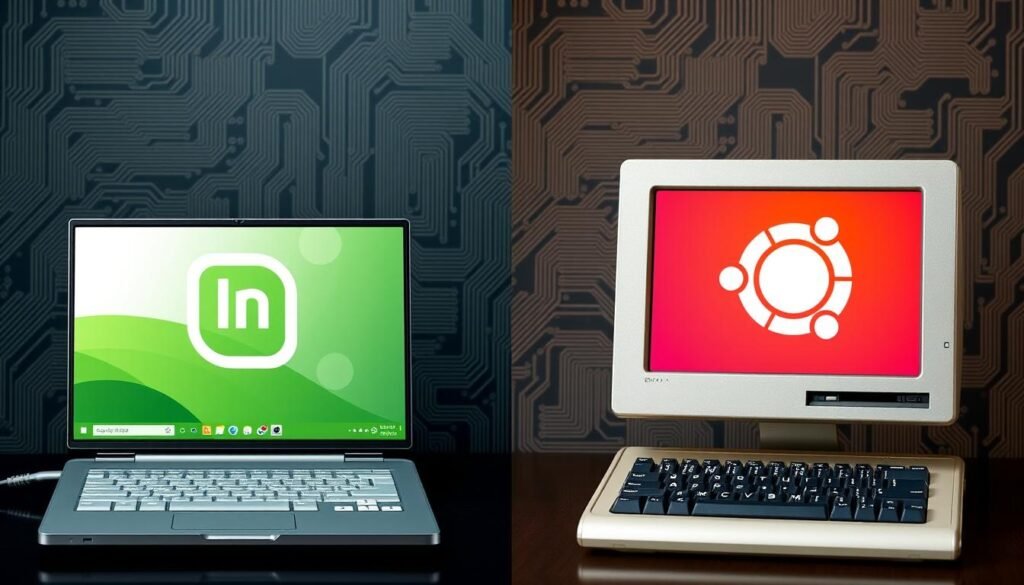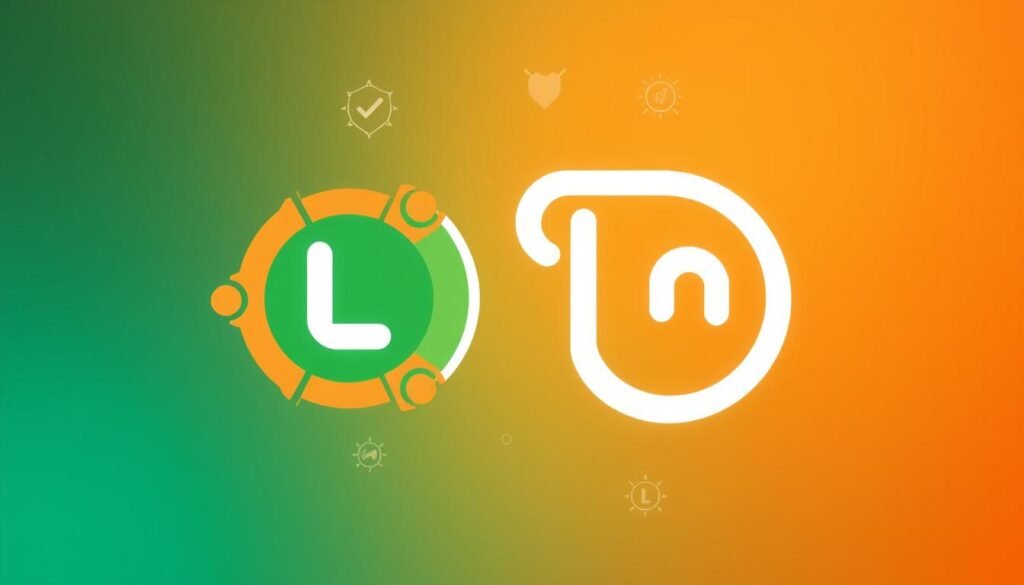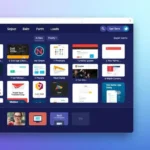Linux distributions have become very popular as open-source alternatives. Linux Mint and Ubuntu are two top choices, both built on Debian. With the Linux market set to hit $15.64 billion by 2027, knowing the difference between these two is key.

Linux Mint is known for being easy to use and offering a full experience right out of the box. It’s great for both new and experienced Linux users. Ubuntu, on the other hand, focuses on being accessible to all users. When choosing between Mint and Ubuntu, consider the interface, performance, software, and community support.
Key Takeaways
- Linux Mint and Ubuntu are popular Linux distributions based on Debian
- Linux Mint prioritizes user-friendliness and a complete out-of-the-box experience
- Ubuntu focuses on accessibility and caters to a wide range of users
- Choosing between Mint and Ubuntu depends on user interface, performance, software availability, and community support preferences
- The worldwide Linux market is expected to reach $15.64 billion by 2027, highlighting the growing importance of open-source operating systems
Introduction to Linux Mint and Ubuntu
Choosing a Linux-based operating system can be tough. Linux Mint and Ubuntu are two top picks. They’re known for being easy to use, stable, and having lots of software options. But they have some key differences.
What is Linux Mint?
Linux Mint was started in 2006 by Clement Lefebvre. It’s a modern, elegant OS that’s easy to use. It’s based on Ubuntu and comes out twice a year, keeping it up-to-date.
Linux Mint shines with its Cinnamon desktop. It’s clean and customizable. It also has tools like the Mint Software Manager to help with software.
What is Ubuntu?
Ubuntu was launched in 2004 by Canonical Ltd. It’s known for being easy and accessible. It’s based on Debian and has a release cycle of every six months, with LTS versions every two years.
Ubuntu uses GNOME by default, offering a modern interface. It has a huge software repository, the Ubuntu Software Center, with many apps and tools.
| Feature | Linux Mint | Ubuntu |
|---|---|---|
| Based on | Ubuntu (debian-based) | Debian |
| Release Cycle | Twice a year | Every six months |
| Default Desktop Environment | Cinnamon | GNOME |
| Package Manager | Mint Software Manager | Ubuntu Software Center |
Both Linux Mint and Ubuntu offer user-friendly and powerful Linux-based operating systems, each with its own unique features and benefits.
Choosing between Linux Mint and Ubuntu depends on what you need. Both are great for exploring Linux and getting a solid, secure OS.
User-Friendly Interfaces: Comparing Mint and Ubuntu
Choosing a Linux distribution means looking at the user interface. Linux Mint and Ubuntu have desktop environments that are easy to use and look good. They meet the needs of different users.
Linux Mint’s Cinnamon Desktop Environment
Linux Mint gives users a choice of desktop environments, with Cinnamon being the most popular. It has a modern look and feels like Windows. This makes it great for those moving from Windows to Linux.
Cinnamon lets users customize their desktop. They can change themes, icons, and panel settings. This makes Cinnamon very flexible and personal.
Ubuntu’s GNOME Desktop Environment
Ubuntu uses GNOME as its default interface. GNOME is known for its clean design and simplicity. It aims to make the desktop easy to use and functional.
GNOME comes with default apps like GNOME Files and GNOME Web. These apps work well with the desktop, offering a smooth experience.
Both Linux Mint’s Cinnamon and Ubuntu’s GNOME desktop environments offer unique advantages, catering to different user preferences and priorities. While Cinnamon provides a familiar and highly customizable interface, GNOME focuses on simplicity and a cohesive user experience.
| Feature | Linux Mint | Ubuntu |
|---|---|---|
| Default Desktop Environment | Cinnamon | GNOME |
| Familiarity for Windows Users | High | Moderate |
| Customization Options | Extensive | Moderate |
| Default Applications | Nemo, Firefox, LibreOffice | GNOME Files, GNOME Web, GNOME Calendar |
The choice between Linux Mint’s Cinnamon and Ubuntu’s GNOME depends on what you prefer. Both have user-friendly interfaces that suit various users. They are good for beginners and advanced users alike.
Installation and Configuration
Linux Mint and Ubuntu make setting up your system easy. They have simple installation processes. A graphical installer helps users through each step.

Linux Mint is great for beginners. It comes with many pre-installed apps. This means you can start using it right away, without needing to find and install software.
Ubuntu offers regular and LTS versions. LTS versions are good for those who want stability and support for up to five years. This makes Ubuntu LTS perfect for businesses and users who want a reliable system.
| Feature | Linux Mint | Ubuntu |
|---|---|---|
| Installation Process | User-friendly graphical installer | User-friendly graphical installer |
| Pre-installed Applications | Wide range of essential tools and software | A basic set of applications |
| Long Term Support (LTS) | Not available | Available (5 years of support) |
Both Linux Mint and Ubuntu have easy installation processes. The choice between them depends on what you need. Do you want a system with lots of apps or one that’s stable for years?
Package Management and Software Availability
Linux Mint and Ubuntu both have great package management and software options. They use Advanced Package Tool (APT) for easy installation and updates. This makes managing software simple.
APT and Software Manager in Linux Mint
Linux Mint is easy to use and relies on APT for package management. You can install software with the command line or the Software Manager. The Software Manager makes finding and installing apps easy.
Linux Mint comes with stable default apps. It also supports DEB and Flatpak packages. This gives users lots of software choices.
APT and Snap Store in Ubuntu
Ubuntu also uses APT for package management. You can install software with the command line or the Ubuntu Software Center. The Software Center makes finding and installing apps simple.
Ubuntu supports DEB and Snap packages. Snaps are secure and easy to install on different Linux systems. The Snap Store in Ubuntu offers many Snap packages.
| Feature | Linux Mint | Ubuntu |
|---|---|---|
| Package Management System | APT | APT |
| Software Installation UI | Mint Software Manager | Ubuntu Software Center |
| Supported Package Formats | DEB, Flatpak | DEB, Snap |
| Additional Package Repositories | Flatpak | Snap Store |
Both Linux Mint and Ubuntu make managing software easy. Linux Mint is simple and stable. Ubuntu offers more choices with Snap packages. Both meet your software needs well.
Performance and System Requirements
Linux Mint and Ubuntu differ in performance and system needs. Linux Mint is great for older hardware because it uses less resources. Ubuntu needs more modern hardware to run well, thanks to its focus on new tech.

Linux Mint’s Efficiency and Suitability for Older Hardware
Linux Mint’s Cinnamon and XFCE desktops are light but modern. They work well on old computers. Its careful updates and kernel handling make it stable and efficient on older machines.
Linux Mint provides a stable and efficient experience that performs well with limited resources, suitable for users with older hardware.
Ubuntu’s Performance on Modern Hardware
Ubuntu works well with many hardware types but needs strong, modern systems. Its GNOME desktop is sleek but uses more resources than Linux Mint’s. Still, Ubuntu is efficient on modern systems, making it good for users with new computers.
| Distribution | Minimum RAM | Recommended RAM | Minimum Processor | Recommended Processor |
|---|---|---|---|---|
| Linux Mint | 1 GB | 2 GB | x86 (32-bit) or x64 (64-bit) processor | Modern dual-core processor |
| Ubuntu | 2 GB | 4 GB | Dual-core processor (2 GHz) | Quad-core processor or better |
In summary, Linux Mint is perfect for those who need efficiency and can’t afford new hardware. Ubuntu is good for those with modern systems. Your choice depends on your hardware and needs.
Stability and Security
Both Linux Mint and Ubuntu are known for their stability and security. Linux Mint uses Ubuntu LTS as its base. This means Mint users get the benefit of Ubuntu’s thorough testing and updates.
Linux Mint also manages updates carefully. It sorts updates by stability level. This lets users choose when to update, keeping their system stable.

Ubuntu, on the other hand, focuses on keeping users up-to-date. Canonical’s security team checks packages and updates them quickly. Ubuntu’s regular updates and support make it a secure choice.
Ubuntu benefits from Canonical’s professional support, regular security updates, and additional security layers like AppArmor, enhancing the overall security of the system.
Linux Mint might get updates a bit later than Ubuntu. But both are serious about keeping users safe. Remember, Linux is generally safer than other risks like data loss.
| Distribution | Stability Approach | Security Focus |
|---|---|---|
| Linux Mint | Relies on Ubuntu LTS base for stability | Regular updates for the latest features and bug fixes |
| Ubuntu | Regular updates for latest features and bug fixes | Dedicated security team and timely security updates |
Both Linux Mint and Ubuntu offer a safe and stable experience. Linux Mint is great for those who want a reliable system. Ubuntu is perfect for those who want the latest updates and security.
Community and Official Support
Choosing a Linux distribution means looking at community and official support. Both Linux Mint and Ubuntu have strong support options. But, they differ in how they offer help.
Linux Mint’s Community-Driven Support
Linux Mint counts on its community for support. The Mint community is known for being friendly and helpful. They offer help through forums, documentation, and online resources.
Even though Linux Mint uses Ubuntu’s updates, it faces challenges. It can’t build its own packages or make runtime adjustments. Still, the Mint community works hard to support users.
Ubuntu’s Official and Community Support
Ubuntu has both official support from Canonical and a huge community. Canonical offers professional support plans. This makes Ubuntu a solid choice for businesses needing help.
Ubuntu also has a large and active community. This community creates lots of documentation, forums, and tutorials. Websites like Ask Ubuntu help Ubuntu users even more.
| Support Aspect | Linux Mint | Ubuntu |
|---|---|---|
| Community Support | Dedicated and helpful community | Massive and active community |
| Official Support | Limited official support | Canonical provides professional support plans |
| Documentation | Community-driven documentation | Extensive official and community-driven documentation |
| Forums | Active forums for user assistance | Large and diverse forums for support |
Linux Mint’s community support is strong, but Ubuntu’s support is more comprehensive. Ubuntu’s large community and official support make it a top choice. It’s great for both individuals and businesses looking for reliable help.
Use Cases for Linux Mint and Ubuntu
Choosing between Linux Mint and Ubuntu depends on your needs. Both are great for different users. They work well for personal use, development, business, and big companies.
Linux Mint for Personal Computing and Developers
Linux Mint is perfect for everyday use. Its Cinnamon desktop is easy to use. It’s great for browsing, writing documents, or watching videos.
Developers love Linux Mint too. It supports many programming languages and tools. The terminal makes installing and managing packages easy.
Ubuntu for Individuals, Businesses, and Enterprises
Ubuntu is good for everyone. It has a polished interface and regular updates. It’s reliable and easy to use.
For personal use, Ubuntu has a lot to offer. It’s customizable and has a huge software repository. Installing apps is easy.
Businesses and big companies will find Ubuntu useful. It’s stable, secure, and scalable. It works well with many hardware and software solutions.
| Use Case | Linux Mint | Ubuntu |
|---|---|---|
| Personal Computing | Intuitive Cinnamon desktop, user-friendly interface | Polished GNOME desktop, feature-rich environment |
| Development | Compatibility with programming tools, efficient terminal | Extensive software repository, regular updates |
| Business and Enterprise | Stability and reliability for small to medium-sized businesses | Long-term support, scalability, and compatibility for enterprises |
The choice between Linux Mint and Ubuntu depends on your needs. Both are strong and user-friendly. They are great for different users in the Linux world.
Choosing Between Linux Mint and Ubuntu
When picking a Linux distro, Linux Mint and Ubuntu stand out. Your choice depends on what you need and your computer’s specs.
Linux Mint is great for those who want a simple, fast desktop. It uses less memory than Ubuntu’s GNOME, which is good for older computers. Its Software Manager also loads quicker and uses fewer resources, making it easier to manage software.
Linux Mint is favored for its ease of use, stability, and performance on systems with limited resources.
Ubuntu, on the other hand, offers a polished interface and regular updates. It’s perfect for both personal and business use. Its GNOME desktop is modern and easy to use, and it gets updates often. Ubuntu also has professional support and extra security features.
| Feature | Linux Mint | Ubuntu |
|---|---|---|
| Default Desktop Environment | Cinnamon (most popular), MATE, Xfce | GNOME |
| Release Cycle | Updates twice a year | Updates every six months |
| Long-Term Support (LTS) | 5-year system updates across all desktop choices | LTS versions available |
| Package Management | APT and Software Manager | APT and Snap Store |
| Support | Community-driven support through forums and documentation | Official support from Canonical, along with community support |
Think about your computer’s needs when choosing. Linux Mint works well on both new and old hardware. Ubuntu needs more modern specs for the best performance.
- Think about what you need (ease of use, customization, software)
- Check if your hardware meets the requirements
- Look at the support and community resources for each distro
- Try both live from a USB to see how they work
In short, picking between Linux Mint and Ubuntu depends on your needs and computer. Think about ease of use, resource use, updates, and hardware. This will help you choose the best Linux distro for you.
mint vs ubuntu: A Head-to-Head Comparison
Choosing between Linux Mint and Ubuntu involves several key factors. These include user-friendliness, customization options, software repositories, performance, and LTS versions. Let’s dive into how these two popular Linux distributions compare in these areas.
Ease of Use
Linux Mint is famous for its easy-to-use interface, perfect for Windows users. Its Cinnamon desktop environment is familiar and easy to navigate. Ubuntu’s GNOME desktop, on the other hand, offers a modern and simple experience.
Desktop Environments and Customization
Linux Mint allows users to customize their desktops to their liking. It offers several desktop environments, including Cinnamon, MATE, Xfce, and KDE. Ubuntu focuses on a consistent user experience with its GNOME desktop.
Software Availability and Management
Both Linux Mint and Ubuntu use the APT system for software management. Linux Mint’s Software Manager is easy to use to install apps. Ubuntu’s Snap Store offers a platform for discovering and installing software. Linux Mint comes with more pre-installed software, like VLC and GIMP.
| Feature | Linux Mint | Ubuntu |
|---|---|---|
| Software Manager | Mint Software Manager | Snap Store |
| Pre-installed Software | More (VLC, GIMP, etc.) | Less |
| Proprietary Software | Included by default | Excluded by default |
Performance and Hardware Compatibility
Linux Mint is known for its lightweight performance, which is great for older hardware. Ubuntu performs well on modern hardware but might need more resources. Ubuntu offers flavors like Xubuntu or Lubuntu for older machines.
Long-Term Support and Upgrades
Ubuntu is famous for its long-term support (LTS) releases, offering up to five years of updates. Linux Mint doesn’t have a set update cycle but often releases new versions around Ubuntu’s LTS. Mint aims for a stable experience without big changes between versions.
Both Linux Mint and Ubuntu are beginner-friendly, offer customization options, and are compatible with various devices. They are excellent choices for users exploring Linux.
Conclusion
Linux Mint and Ubuntu are both great choices, each with its own strengths. Linux Mint is perfect for beginners and those with older computers. It has a traditional look and comes with useful apps like the update manager and Timeshift.
Ubuntu, on the other hand, is great for all users, including businesses. It has a modern design and lots of software options. Plus, Canonical offers official support.
When picking a distro, think about what you need. Consider ease of use, desktop look, software, performance, and support. Linux Mint’s Cinnamon desktop is easy to use, while Ubuntu’s GNOME is more modern.
Both have lots of software, but Linux Mint’s Software Manager is faster. Your choice depends on what you want and need. If you like simplicity and older hardware, go with Linux Mint.
If you want something modern and supported, choose Ubuntu. Both Linux Mint and Ubuntu offer great Linux experiences. They are reliable, secure, and easy to use for many different needs.
FAQ
What are the main differences between Linux Mint and Ubuntu?
Linux Mint and Ubuntu have different desktop environments and user interfaces. Mint is simple and familiar. Ubuntu offers a modern, cohesive experience. Mint uses less system resources, while Ubuntu needs more but provides a polished user experience.
Which distribution is more beginner-friendly, Linux Mint or Ubuntu?
Both are beginner-friendly, but Mint is better for new users. It has a traditional desktop and includes essential tools. Ubuntu’s interface might be harder for Windows users to learn.
Can I run Linux Mint or Ubuntu on older hardware?
Linux Mint is great for older hardware because it’s efficient. Ubuntu is also lightweight but might need more resources, especially with its GNOME desktop.
How do Linux Mint and Ubuntu handle software installation and updates?
Both use APT for package management. Mint has a Software Manager for easy app installation. Ubuntu also uses APT and supports Snap packages for easy updates.
Which distribution offers better community support, Linux Mint or Ubuntu?
Both have strong communities for support. Ubuntu also has Canonical’s professional support and official support plans. This makes it good for businesses and enterprises.
Is Linux Mint or Ubuntu better suited for developers?
Both are good for developers, offering many programming tools. Mint is popular for its lightweight nature and easy terminal. Ubuntu has extensive software repositories and official support.
Which distribution should I choose for long-term stability and support?
Ubuntu’s LTS versions offer five years of support, making it reliable for long-term use. Linux Mint uses Ubuntu’s LTS releases for stability without big changes.
Can I customize the desktop environment in Linux Mint and Ubuntu?
Both offer customization options. Mint’s Cinnamon desktop is very customizable. Ubuntu’s GNOME desktop is more streamlined and consistent.





